Matthew S. Williams's Blog, page 16
November 22, 2021
Behold! The Venus Calendar!
Recently, I learned that there’s an actual Martian calendar, known as the Darian Calendar. It was crafted by aerospace engineer Thomas Gangale in 1985, who named it after his son Darius. It was also adopted by the Mars Society in 1998 and will be the official calendar of Martian settlers (if and when permanent settlements are built on Mars someday).
It’s specially made for Mars, which has a very similar diurnal cycle to Earth – a day (or Sol) is 26 hours long. But since a year is almost twice as long, the calendar has 24 months, which are divided into blocks of 6 months each. Each month has 28 days, except the last in a block (which has 27). According to the description on Wikipedia, the calendar is structured as follows.
“The year is divided into 24 months. The first 5 months in each quarter have 28 sols, while the final month has 27 sols unless it is the final month of a leap year, when it contains the leap sol as its final sol. The calendar maintains a seven-sol week, but the week is restarted from its first sol at the start of each month. If a month has 27 sols, this causes the final sol of the week to be omitted.
“This is partly for tidiness and can also be rationalised as making the average length of the Martian week close to the average length of the Terrestrial week; 28 Earth days is very close to 27+1⁄4 Martian sols, whereas a month is an average length of 27+5⁄6 Martian sols. In the table, the sols of the week are Sol Solis, Sol Lunae, Sol Martis, Sol Mercurii, Sol Jovis, Sol Veneris, Sol Saturni.”
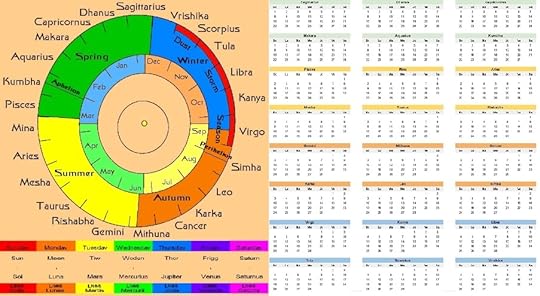 Credit: ops-alaska.com
Credit: ops-alaska.comWell, guess what I decided to make? A calendar for Venus! Granted, this is a dating system that will only work if and when humans speed up the planet’s rotation to give it a 24 hour period (an essential aspect of terraforming Venus). Once that is done, the planet will need to have a calendar that can accommodate a 224.7 day year.
Doing the math, I found that a week of 5 days, a three-week month, 15 months, and a “leap year” every 10 years (where it’s actually three days shorter) would work. And the months and days all take their names from different cultures and the names they ascribed to the planet Venus or the associated fertility goddesses.
Here’s how it breaks down: The days of the week are Sol Khonsu, Sol Winalagalis, Sol Rosmerta, Sol Tohil, and Sol Inanna, the corresponding deities to Luna, Twi, Woden, Thor, and Freya – for whom the days of Monday to Friday are traditionally named.
Monday Tuesday Wednesday Thursday FridayMoon
–
Luna
Twi
–
Mars Woden
–
Mercury Thor
–
Jupiter Freya
–
Venus Sol Khonsu Sol Winalagalis Sol Rosmerta Sol Tohil Sol Inanna
Meanwhile, the 15 months are all named after fertility goddesses from various religions and cultures. Their names (in alphabetical order) are Anahita, Aphrodite, Atahensic, Attar, Barnumbirr, Chapska, Cliodhna, Denke, Kokopelli, Oshun, Quetzalcoatl, Śukra, Tioumoutiri, Wünelve, and Zohra.
In keeping with the naming conventions of the Formist Series, I have decided to stick with the adjective “Cytherean,” as opposed to “Venusian.” I feel it sounds better and does a better job of conveying the mythos behind the names of the Solar planets. Having said all that, here is how it will look!
Behold, the Cytherean Calendar (patent-pending!):
Attar Zohra Barnumbirr 1 2 3 4 56 7 8 9 10
11 12 13 14 15 1 2 3 4 5
6 7 8 9 10
11 12 13 14 15 1 2 3 4 5
6 7 8 9 10
11 12 13 14 15 Aphrodite Denke Oshun 1 2 3 4 5
6 7 8 9 10
11 12 13 14 15 1 2 3 4 5
6 7 8 9 10
11 12 13 14 15 1 2 3 4 5
6 7 8 9 10
11 12 13 14 15 Anahita Kokopelli Cliodhna 1 2 3 4 5
6 7 8 9 10
11 12 13 14 15 1 2 3 4 5
6 7 8 9 10
11 12 13 14 15 1 2 3 4 5
6 7 8 9 10
11 12 13 14 15 Quetzalcoatl Śukra Chapska 1 2 3 4 5
6 7 8 9 10
11 12 13 14 15 1 2 3 4 5
6 7 8 9 10
11 12 13 14 15 1 2 3 4 5
6 7 8 9 10
11 12 13 14 15 Atahensic Tioumoutiri Wünelve 1 2 3 4 5
6 7 8 9 10
11 12 13 14 15 1 2 3 4 5
6 7 8 9 10
11 12 13 14 15 1 2 3 4 5
6 7 8 9 10
11 12 13 14 15
October 30, 2021
Revitalizing an Old Idea: Thirteenth
It came to me when I was in University and eventually grew to become the seed of my very first written work. It was intended to become part of a series called Legacies, and I had big plans for it. I even wrote a few short stories over the years that were part of this fictional universe. However, as years passed and I became more committed to hard science fiction, I fell out of love with the series. Since it was my first effort, I also felt that the writing was amateurish and needed serious polishing.
But the other day, I found myself musing about the seed. It wasn’t a bad idea, and I could still recall the sense of inspiration I felt when plotting it all out. And over the years, the basic concept was still there, always trying to find expression in new form or variation on the old. I can’t help it. There’s just something about ancient migrations, long-lost tribes, and forgotten histories that is so damn intriguing!
And since I’m at a transitional point in my writing – my first trilogy down and an open field in front of me – I’m once again contemplating if this idea has a future. While it’s not exactly hard science-fiction (more space opera), I still think it has the potential to be fun and intriguing.

So here’s how it breaks down. Picture it as the opening crawl of the movie…
Several centuries from now, the human race has accomplished the dream of interstellar exploration and settlement. This was made possible by the Gateway, a revolutionary technology that relied on negative mass to create artificial Einstein-Penrose bridges (“wormholes”). The process of expansion was initially slow, since these gates needed to be established at both ends of the bridge. But in time, many bridges to many new systems were established.
What followed was a period of unprecedented growth as new systems were explored, planets were settled, and the reach of humanity extended further. But as always, old habits followed the human settlers to new worlds. On several frontier territories, settlers began to clash over land, rights, resources, and differences of every kind.
Restoring peace among these newly-established outposts of civilization required that Earth create the first interstellar military force. Thus was born the Interstellar Terran Corps (ISTC), which oversaw defense and enforced the peace, which consisted of the Kaigun (Fleet), the Raumjäger (Infantry), and the Kosmicheskiy (Aerospace Corps).
The Office of Adjudicator General (OAG) was also created to rule on matters of interstellar law and help resolve conflicts. This brought an end to local skirmishes and conflicts between settlers that threatened to become full-scale disasters.
Over time, new problems emerged. After reaching the limits of what could be settled and administered, a sense of listlessness became apparent. The more-developed settlements began threatening to break away while the periphery became more difficult to administer. Breakaway republics emerged that sought independence. Some chose to do it peaceably, others violently.
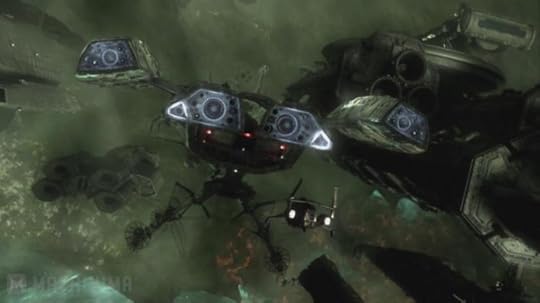
Consequently, the same military forces created to restore peace and order were called upon to perform another duty. ‘Peace at any cost’ soon became the thinking of those who had governed a united human race for many generations.
For those living in the Settled Worlds, a terrible decision had to be made. Some chose to fight, others to wait, and others still to break out and seek new worlds where they could live freely and be safe from the conflict raging across known space. One such group was the Hagirah Flotilla, a collection of colony ships that departed known space searching for greener pastures.
The Flotilla included vessels from multiple settled worlds, including the Tanga, the Vándorol, the Reika, the Tirugu, and the Tenüüchlekh. All told, over 150,000 human passengers departed with the Flotilla, seeking a new home in another Sun-like star system. According to all available accounts, the Flotilla disappeared shortly after passing through the 82 Eridani system.
They were never heard from again.
Fast-forward a few centuries. After a prolonged conflict that turned into a full-blown civil war, the Earth-centered government was finally overthrown. Several localized skirmishes and deliberation followed, but in time, peace and stability returned to the known Universe. Even unity was restored, eventually, but only after the government of Earth agreed to grant local planets autonomy and repair the damaged gateways.
But just as it seemed like the worst conflict in human history was behind it, there’s a disturbance in the outer reaches of space. In one of the farthest systems explored, a strange object appears seemingly out of nowhere. When Terran ships are sent to investigate, they are quickly destroyed by this object, which is clearly the work of a highly advanced species. There had been rumors of extraterrestrial civilizations for generations, as evidenced by ruins and debris that clearly were once starships.

Many expected that it was only a matter of time before a new civilization showed up on our doorstep. Before this theory could be confirmed or even investigated further, a broadband message is received from the outer reaches that shocks and astounds anyone who sees it. Not only it is decipherable and readable in human text, but it is also only a few words, the deeper meaning of which cannot be denied:
“Humanity’s children have come home.”Many more ships appeared in the outer reaches and began pushing their way into Terran-occupied space, destroying any resistance in their way. The mystery of the Hagirah Flotilla, which had long since faded into legend, was finally resolved. How they had managed to assemble a fleet of such size and where their advanced technology came from was a mystery that would take several more years to resolve. In the meantime, humanity had to mobilize itself for another terrible war.
This newer version of the idea takes advantage of many concepts and scientific research that I’ve picked up over the years (mostly in my capacity as a science communicator). These include “Percolation Theory,” which imposes limits on the extent to which a species can expect to create an “interstellar empire.” There’s also “non-convergent evolution,” the science behind Near-Light-Speed (NLS) propulsion, and even some of the theoretical work regarding wormholes.
But the basic idea of a “13th tribe” returning after generations to wage war on the parent civilization remains. I would say more about the idea, like where the 13th tribe’s fancy new technology came from, why they were intent on waging war on Terran civilization, and how they disappeared and managed to find their way back. But that would be venturing into spoiler territory.
October 15, 2021
Talking About “the Process” – Part the Second
The last time I got into one of these, it was because a friend asked me some engaging questions. And so I talked about the one thing I never liked to talk about. And wouldn’t you know it? I actually enjoyed it. And it turns out that some people actually read it and found it interesting. So I thought I’d suck it up yet again and get into something else that is process-related. Again, this is something I don’t normally like to talk about. But it’s something that writers are frequently asked, myself included:
“Where do your ideas come from?”This has to be one of the most challenging questions to answer! The reason, in my case, is that the answer is so unsatisfying. I wish I could say that there is a special process or method that all writers use. But I’ve been doing this for eighteen years now, and I still haven’t found the magic formula or the proverbial secret door which leads to the magical realm of inspiration. If I’m being completely honest, the only answer I can give is “wherever I find them.”
It reminds me of something I read many years ago about how there are two types of reasoning and problem-solving (I believe it was Asimov who wrote it). He said there’s the conscious type, where we force our minds through previously-formed channels in our brains, looking for answers. Then there’s the unconscious, “latent” type of reasoning that happens without our being conscious of it. This is the kind of reasoning that manifests itself in an “AHA!” moment when the answer dawns on us.

The legend of Archimedes’ principle is a perfect example. According to the legend, the Greek polymath Archimedes was tasked with finding a way to determine the density of metal objects without melting them down. After many sleepless nights pondering the problem, his wife recommended that he take a bath. While lowering himself into the tub, Archimedes realized that the mass of his body displaced a certain amount of water-based on its weight.
Archimedes then jumped from the bath and ran through the streets naked, shouting “Eureka!” (Greek for, “I have found it!”) While this story is likely apocryphal, it demonstrates the difference between conscious and latent reasoning and how humans appreciated that difference long before modern psychology or neuroscience. Basically, if you’re stumped, don’t torture yourself by going over the problem again and again. Do something to distract yourself, give your conscious brain a rest, and a breakthrough will come.
It’s the exact same way with ideas. They start like seeds planted in the unconscious mind, and every so often, one will germinate and trigger an “AHA!” moment when you least expect it. That’s when you need to examine the idea and work on it with your conscious mind, which means structuring it, detailing it, and adding all the necessary ingredients (plot, characters, themes, twists, pacing, etc.). Once that is done, the idea is fully formed and ready to be realized.
The only way I could explain any further would be to give you some examples. As it happens, I can remember the exact moment when the idea for my first novel – The Cronian Incident – first came to me. It was 2015, and I had recently taken on the role as the Curator for the Guide to Space section at Universe Today and was working my way through a collection of articles about the Solar System. I had just finished doing the one on Mercury and was quite intrigued by some of the things I learned.
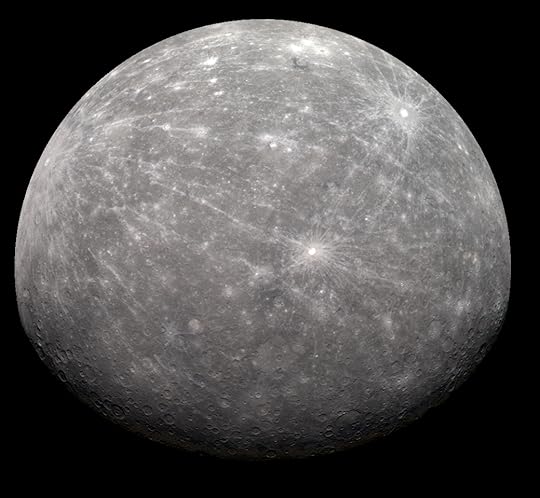 NASA
NASATo break it down, Mercury takes 58.64 days to complete a rotation on its axis and 88 days to complete a single orbit around the Sun. This results in what is known as a 3:2 spin-orbit resonance, where the planet rotates on its axis three times for every two orbits it makes of the Sun. While some conclude that this means three days is equal to two years on Mercury, they would be wrong. Due to the nature of orbital mechanics, a day on Mercury – that is, the time it takes for the Sun to rise, set, and rise again (24 hours here on Earth) – lasts 176 days!
So really, a single day on Mercury lasts as long as two years! Another interesting thing is that because Mercury is airless (no atmosphere), the Sun-facing side becomes extremely hot while the side facing away becomes extremely cold. When I was younger, I remembered reading several science fiction novels where the planet Mercury had settlers on it, people who called themselves Hermians (from the root word “Hermes,” the Greek messenger god and the inspiration for the Roman god Mercury).
It occurred to me that if human settlers were to remain on the night side of the planet, taking care to stay mobile and remain ahead of the Terminator (the boundary between night and day), they could survive and take advantage of the mineral wealth and abundant energy Mercury has to offer. I began discussing this with a friend via Facebook (also a writer of SF), and we started bouncing ideas back and forth. Eventually, he hit me with a challenge that forced me to get creative.
Why would anyone need Mercury’s wealth when they could mine it from asteroids much closer to home? I ventured that perhaps demand would eventually become great enough to justify sending humans there, but that seemed a bit flaccid. That’s when it hit me: what if no one who was there went by choice? What if Mercury became a penal colony where people went to work off their debts or a prison sentence? By the time I bounced that idea off my friend, the lightbulb went on in my head!
 Debivort
DebivortSuddenly, I realized that stories of how human beings might someday colonize the Solar System was something I was finally informed enough to write about. My day job consisted of writing about astronomy, space exploration, and actual proposals to expand humanity’s presence beyond Earth. So why just write about Mercury? What about all the larger objects in the Solar System? How would human beings live on these bodies in the future, what kind of lives would they lead, and what stories would they tell?
I immediately began writing down notes and looking for a storyline that could touch on these questions while also dealing with some other themes I was hoping to include. Since 2012, I have wanted to do a story that would address the major forces for change in this century and beyond. The possibility that these might be driving forces for humanity becoming “interplanetary” felt like a natural fit. From that, The Cronian Incident was born and was followed by two sequels – The Jovian Manifesto and The Frost Line Fracture.
See what I mean? Describing where an idea came from is akin to telling an origin story. You have to acknowledge influences, establish the context, then show how it unfolded in your mind over time. In short, you have to tell the story of how you created the story. And at this point, I got a hundred of them, and I’m not speaking euphemistically! Someday, I hope more of them make it to publication so I can share the story of where the ideas came from too!
September 5, 2021
Talking About “the Process” – Part the First
Recently, a friend of mine raised the subject of my writing process, how I go from receiving an assignment and/or getting ideas to researching the topic, deciding on an approach, and so forth. In short, he said that if I were ever to write an article where I share my personal experiences and preferences, he would happily read it. While I was understandably flattered, my first instinct was to groan at the mere mention of those two words:
“The Process”I don’t why, but for about as long as I’ve been writing at a professional level, I’ve found this kind of talk both painful and tedious. Maybe it’s the way I’ve grown tired of introspection over the years, or maybe the way I prefer that discourse be focused on material rather than method. It’s like that witty line David Hyde Pierce once uttered on Frasier: “This is boring, yet difficult.”
Still, it’s an important subject and a crucial part in how things get created. For the sci-comm (science communicator), it’s all about taking raw information that is often inaccessible and translating it into an accessible narrative. It’s also about taking discoveries and developments that might otherwise appear to be happening in a vacuum and relating the context in which it happened, and the implications going forward.
So I decided to suck it up and relate what I could about this topic. For convenience sake, I have decided to address it in a Q&A format:
How did you get into science journalism?It was a bit of a journey and began with a chance meeting with the man who would become my boss. Back in 2010, I was a substitute teacher living in the Victoria, BC, area with my wife and cat. We had moved there from the town of Comox about a year before. While visiting Comox again, I dropped in on a friend whom I knew through Taekwon-Do. She introduced me to her husband, Fraser Cain, the founder and publisher of Universe Today.
Fraser had heard from her that I was an aspiring SF writer and teacher, and we got to talking and Fraser decided to take me under his wing. Everything else followed from that one encounter…
On the one hand, he wanted to mentor me on how I could skip the whole “waiting to be discovered” thing and become an independent author. This included tutoring me on how to utilize self-publishing services, social media, self-promotion, website-building, etc. On the other, he offered me some part-time writing work for Universe Today, writing short pieces for their Guide to Space section (which is the sort of the “Encyclopedia Galactica” section of their website).
Bigelow Inflatable Module to be Added to Space Station in 2015My first article for Universe Today, posted on October 13, 2014
After a few years of dividing myself between teaching and writing, Fraser announced that some big changes were in the works. Universe Today was expanding and he offered me a job writing full-time for them, doing regular pieces about news and day-to-day developments. He also extended an offer to write for HeroX, the crowdfunding platform founded by entrepreneur and futurist Peter Diamandis, which was launching at the time.
While I was not formally educated in astronomy or physics, my fascination and passion for science and space is apparently why Fraser chose to keep me around. That, and the fact that I was an educator with writing experience, meant that I could convey space and science-related stuff to people who similarly lacked a formal education in the subject matter. Basically, I was a layperson making science accessible for other laypersons.
A year later, I quit teaching to become a science journalist full-time, which coincided with Fraser promoting me to the role of Curator for the Guide to Space section. By 2016, I was approached by a publisher (Castrum Press) regarding an idea I was working on that explored the future of humanity in space. By 2017, my first novel, The Cronian Incident, was published, which was followed by two more – The Jovian Manifesto and The Frost Line Fracture – in 2018 and 2020 (respectively).
In 2019, I branched out and became a member of Interesting Engineering as an evergreen content writer, which means I long articles about topics that remain relevant for long periods of time. In 2020, I joined Mars City Design as their Director of Media Communication, where its founder and CEO (Vera Mulyani) and I began working on a podcast series called “The Martian Dispatches,” which will be released shortly (and is available for preorder).
And to think, it all started with a chance meeting!
Where do ideas come from? What percent?That’s a good question, and one that requires a little preamble. The content I write generally falls into one of two categories: Everyday Content, and Evergreen Content. Whereas “everyday” refers to news items that are transient and time-sensitive in nature, “evergreen” refers to stories that are ongoing and remain relevant for long stretches of time.
While everyday stuff accounts for about 70% of the articles I write, evergreen content accounts for another 20%.
To give you some examples, stories like “NASA declares new policy for lunar exploration” or “China shares its plans for a lunar base” are everyday news items because they represent a sudden and big change or development. They’re also considered time-sensitive because they are subject to change and will likely be updated before long. For these topics, there is a boat, and you don’t want to miss it!
These are generally assigned to me by an editor. It is their job to sort through all the daily developments and find the stories worth telling. This is typically done by editors who test out story ideas and titles via social media to measure the level of public engagement it gets. If it’s high, people are interested and want to learn more. If it’s low, they’re not interested and its probably best to cover something else.
Unlike everyday news items, evergreen content is much more general and historical in nature. For example, a question like “what are the planets of the Solar System?” requires historical context. First, you need to look at how and when the known planets were discovered, how the definition of “planet” has evolved over time, and why this is of significance today. Alternately, a question like “what are quasars?” is more of a general knowledge question meant to clarify terminology.
Beyond these two categories, I would say there is a third – Passion Pieces – which make up the remaining 10% of the content I create. These are the subjects that I am most interested in talking about and want to educate the public on. A perfect example would be “What’s up with Megastructures?” These are almost always things I’ve pitched to editors, and are generally accepted because they also think they’re cool! 
 This is a Shkadov Thruster (or stellar engine), an example of a hypothetical megastructure. Nuff said?
This is a Shkadov Thruster (or stellar engine), an example of a hypothetical megastructure. Nuff said? Credit: Neil BlevinsAre there any topics you find interesting but can’t write about much because your readers don’t share those interests?
I have yet to find such a topic, but I can definitely say that my own interest in some topics probably exceeds the majority of readers.
Do you have to pitch your ideas very hard to get them written?Not really. But as you get more experienced, you tend to learn which ideas are more likely to draw an audience. As such, your pitches are likely to have a greater acceptance rate over time.
Do you get sick of explaining Schrodinger’s cat every single #$@#ing time you have to write an article on QM?Lol! You know, it’s never come up. I don’t handle QM as a topic much, but when I do, I have found I can get away without that allegory.
Do you often wish you could spend more time writing an article or explaining more, but just have to call it done?Happens all the time!
In the unlikely event you ever quote me, are you willing to write what I obviously meant instead of using a bunch of ellipses, brackets and [sic]s?Can. Will. Did (look around) 
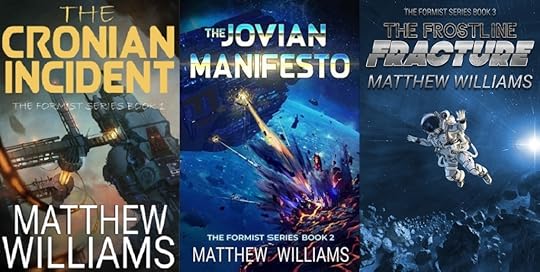 My books so far!How do you structure a story? Do you have a few templates that you generally apply?
My books so far!How do you structure a story? Do you have a few templates that you generally apply?I do have a template, but it’s not mine. In general, I go with the classic 5 Paragraph Essay structure, though I rarely write articles that short (if ever!) It’s more like the 5 Part Essay, with the number of paragraphs varying depending the breadth and level of detail I think is required. It goes like this:
Part I – Introduce general topic (“the hook”)Part II – Introduce specific topic (i.e., address the headline)Part III – Get into the detailsPart IV – Show the significance and present related informationPart V – ConclusionAt other times, I will do a truncated version of this, where there’s really only four parts and I get into the news item right away. But for longer articles (like Guide to Space or Interesting Engineering articles) I generally go with the labelled approach. In that case, its more of a question of sections, addressing all the pertinent topics related to the subject. For example, if I wanted to talk about something big like the Search for Extraterrestrial Intelligence (SETI), it would look something like this:
Section I – Intro and general overview of SETISection II – Definition and important conceptsSection III – History of SETI Section IV – What are we looking for? (biosignatures and technosignatures) Section V – Limitations and the futureSection VI – Conclusion (will we ever find them?)How do you research something you know little about? How do you feel when you have to write a story and haven’t got a level of understanding you are happy about?Glad you asked, because it emphasizes the most important lesson I’ve learned from being a writer. It doesn’t matter if you’re writing as a science communicator or a science fiction author, the rule is the same.
Do your homework!Regardless of the topic, whether you feel confident or not, you should always be prepared to do background reading and familiarize yourself with what it is that you’re writing about. As for how you do that, it’s not that complicated. It’s good to have trusted sources on lock that will give you a good idea of what you’re dealing with. And always try to find source material that is presented in such a way that you aren’t overwhelmed by the details.

Remember, you only need to understand it to the point where you can explain it to a person with no formal education on the subject. If you find yourself in that same boat to begin with, it works out well! By acting as the “technical translator” who learned how to interpret the data, you’ve effectively shown people that with a little research, complex subjects that seem entirely inaccessible at first glance can be made accessible.
How frustrated [are] you by perfectionism?Not that much, honestly. I have never been too detail-oriented, which is why my earlier work suffered from typos and errors that (in spite of editing) survived the final draft! However, I am very much the obsessive compulsive when it comes to doing justice to a topic, which means pulling in added sources, doing my diligence on sourcing and attribution, and making sure I got any affirmative claims correct. For example, “there’s plenty of Helium 3 on the Moon.” How sure am I of that? It can be frustrating because it’s a big time-consumer!
What’s the deal with headlines?I know, right? Those are probably the part I like the least. They need to be succinct, to the point, and attention-getting! Of course, people will naturally accuse you of “clickbait” if they feel the title is the slightest bit misleading, and I’ve found the threshold on that is set very low. Then again, it obviously worked on them!
What do you like most and least about your job?The thing I like the most about my job is that I get paid to do what I love. I feel especially fortunate for that, and owe many people a great debt for it as well. Sure, I worked hard along the way, but I would never be here were it not for people like Fraser and others who took a chance on me. I also love my job because it means I get to write about things I’m passionate about, relate it to others, and know that it’s actually making an impact.
To quote the old cliche, “do what you love and you’ll never work a day in your life.” Speaking of cliches, I also learned that there is such a thing as a “silent majority.” For awhile, I was used to getting (mostly) positive feedback from the people I wrote for. The comment boards, in contrast, were not a place where constructive criticism could be expected to happen. Mostly, people posting thoughts just wanted to show how much more they knew about a topic or to criticize my coverage of it.

However, it wasn’t before long that I realized that there were people who read my articles regularly and enjoyed my work. I began to be invited to give talks to astronomy societies, writing positions with other sites, and advertisers started bugging me like I mattered. How strange it is, to be doing what you love, and then someday find out that you actually have “fans.” I guess you could say that the “silent majority” doesn’t stay silent for long!
In terms of what I like least, I would say it has to do with some all-too-common attitudes that are out there. Often, people will respond to articles about space exploration and innovation with a combination of denial, recrimination, and good old fashioned hostility. Seriously, I can’t keep track of how many times people have said “this is stupid, we can’t even live on Earth!” or asked “shouldn’t this money be spent on fixing Earth instead?”
At other times, people have posted comments like “just admit the Earth is flat!” (that actually happened), that climate change is not real, that the government is experimenting with alien tech, and there’s a huge government conspiracy to cover all this up! This is concerning since it raises the issue of how misinformation and counter-knowledge have become so prevalent today and are treated by many as truth. It also highlights the importance of science communication in today’s world.
The only other thing I don’t like (more of a pet peeve, really) is people responding to titles. Oftentimes, we will post articles in the form of a question – i.e. “Why is the Earth round?” The question is asked, then answered, in the article itself. Simple, straightforward, and ideal when it comes to Search Engine Optimization (SEO). Many people, however, post answers to the title. I’m not sure why, but this annoys me. It’s like, “That’s a rhetorical question and the answer is in the article! Read it!”
Okay, that’s me done! Anyone else want to talk about their process?
June 17, 2021
Introducing The Martian Dispatches!
At long last, this special project (which I’ve been busy with for many months) has been released. Which means I can finally talk about it! But first, a little preamble…
About a year ago, I joined Mars City Design®, a non-profit innovation and design platform dedicated to merging architecture, design, and the creative industry with the commercial space sector (aka. NewSpace). Since their inception in 2016, they’ve hosted an annual design competition where architects and designers from around the world submit ideas for how humans could live sustainably on Mars someday.
Every year has a different theme, which in recent years has included Urban Design and Architecture, AI Robotics and Engineering, Transportation, Sports, and for the 2020 competition, Urban Farming. Their founder and CEO, Vera Mulyani is basically a rock star in the architecture, art, and commercial space industries. As a scicomm (science communicator), we know many of the same people and run in the same circles.
Eventually, we made introductions during a virtual conference hosted by Explore Mars (of which she in a Director and I a member) and I learned what she and her organization did. My interest was piqued, and I asked if I could do a write-up on them for Universe Today. Vera was suitably impressed and asked me to join MCD as a media communicator shortly thereafter. That’s when the collaboration began!
 Mars City Design®
Mars City Design®A year later, Vera and I co-wrote a series of podcasts together! Each episode is basically an account of what it’s like to live on Mars in the future, as told by a fictional character. It’s called The Martian Dispatches, and the first volume (3 episodes) is now available on Amazon.com! Each story features elements of MCD’s design competitions and explores a different aspect of what it’s like to live on Mars 100 years after human settlers first set foot on the surface.
Here’s the intro for the series:
“Have you ever imagined what future life will be like on Mars… three or four generations from today?
That’s right. Your great grand kids may actually be born on Mars! While you may never get to meet them, you certainly can imagine what their phenomenal lives will be like. And we can help.
Because at Mars City Design®, that’s what we do.
Imagining possibilities. Constantly. But we’re also working to make them a reality; A future where humans can live and thrive on Mars!
To provide a glimpse of this future, we proudly present The Martian Dispatches – a podcast series that imagines this future works, told by actual Martians. Through these tales of life on the Red Planet, which soon will be published on the Space Channel, we hope to share with you our uplifting, beyond non-dystopian vision of the future!
You may also guess, which celebrities or space pioneers, are behind these voices. One hint: our Premier played the voice for Jenny the robot, on Kanye West’s 808s and Heartbreak world tour.”
And here’s a teaser trailer. The segment comes from the episode Mangala Hotsprings, and is narrated by famed Canadian recording artist Esthero.
February 28, 2021
Science Fiction, Babylon Style!
There are times when ideas come along that just feel inspired. Then there are times when you think, “this is something I really should do because it sounds awesome in concept.” Those are the kind of ideas that you know readers will appreciate, provided you can do them justice! Otherwise, they’ll just sit on the shelf (or your Documents folder) and gather dust. The following list of ideas sort of straddle these two categories.
They came to me while researching ancient Mesopotamian myths that remain a part of our culture today. In fact, many of the myths that are considered to be foundational to western culture trace their roots to the “land between two rivers” (between the Euphrates and Tigris rivers). Here are the ideas I was mulling over after reading up on some ancient myths.
The Enki EffectThis idea was inspired by an article I did for Universe Today regarding a study titled, “Language Development During Interstellar Travel.” It was an especially exciting topic because, with a little added research, I was able to illustrate how words and language conventions could transform over the course of 10, 20, or more generations. It wasn’t enough just to do an article, I had to keep that train going! So here’s what I came up with…
In the distant future, humanity has expanded beyond Earth to becoming both interplanetary and interstellar. Unfortunately, the earliest missions took several generations to arrive at their destinations, and follow-up missions took many generations more. Thanks to improved technology, interstellar missions are able to reach nearby stars at near the speed of light (NSL), since faster-than-light (FTL) travel is impossible.
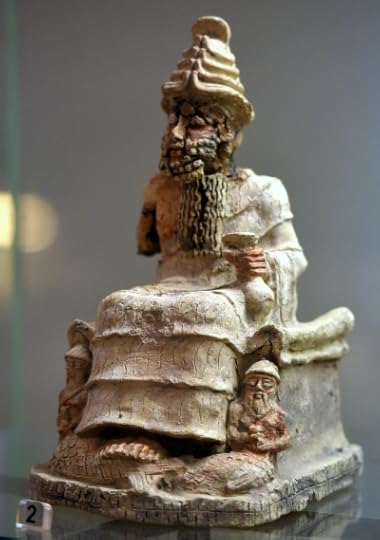
There are efforts to bring all human colonies under one roof. The biggest challenge to this, aside from logistics, is linguistics! Being apart for so long, human language has evolved in many different directions and efforts must be mounted to establish a common language. On the one hand, cultural exchanges are planned to allow people from every colony world to come together and learn from each other. On the other, linguists are sent to different worlds to study how the locals speak, as well as finding commonalities that could lead to a universal tongue (vocabulary, syntax, morphology, etc.).
This is known as the Enki Effect, which is all about people learning to understand each other. The theme is based on an ancient Sumerian myth known today as Enmerkar and the Lord of Aratta. I selected this story specifically because I was especially intrigued by it, largely because of how it and the Tower of Babel story from Hebrew mythology are linked. The Babel story appears in the Book of Genesis (Chapter 11, verses 1-19):
“And the whole earth was of one language, and of one speech. And it came to pass, as they journeyed from the east, that they found a plain in the land of Shinar; and they dwelt there. And they said one to another, Go to, let us make brick, and burn them throughly. And they had brick for stone, and slime had they for morter. And they said, Go to, let us build us a city and a tower, whose top may reach unto heaven; and let us make us a name, lest we be scattered abroad upon the face of the whole earth. And the LORD came down to see the city and the tower, which the children of men builded.
And the LORD said, Behold, the people is one, and they have all one language; and this they begin to do: and now nothing will be restrained from them, which they have imagined to do. Go to, let us go down, and there confound their language, that they may not understand one another’s speech. So the LORD scattered them abroad from thence upon the face of all the earth: and they left off to build the city. Therefore is the name of it called Babel; because the LORD did there confound the language of all the earth: and from thence did the LORD scatter them abroad upon the face of all the earth.”
In contrast, Enmerkar and the Lord of Aratta is a story about how languages were united during a particular crisis. It all began when the city of Uruk and Aratta (a rival state possibly in Iran or Armenia) were competing for the affections of Inanna (Ishtar). Whereas the lord of Aratta has himself crowned in Inanna’s name, she is more taken with the temple the city of Uruk has erected for her.
 Tower of Babel by Pieter Brueghel the Elder (1563). Credit: Wikipedia Commons
Tower of Babel by Pieter Brueghel the Elder (1563). Credit: Wikipedia CommonsThe King of Uruk offers to subdue Aratta in Innana’s name and sends an emissary to Aratta to demand tribute. In order for the declaration to be made, the emissary must recite the “Incantation of Creation,” a hymn imploring the god Enki to restore linguistic unity to all the regions of the land:
“On that day when there is no snake, when there is no scorpion, when there is no hyena, when there is no lion, when there is neither dog nor wolf, when there is thus neither fear nor trembling, man has no rival! At such a time, may the lands of Shubur and Hamazi, the many-tongued, and Sumer, the great mountain of the me of magnificence, and Akkad, the land possessing all that is befitting, and the Martu land, resting in security – the whole universe, the well-guarded people – may they all address Enlil together in a single language! For at that time, for the ambitious lords, for the ambitious princes, for the ambitious kings — Enki, the lord of abundance and of steadfast decisions, the wise and knowing lord of the Land, the expert of the gods, chosen for wisdom, the lord of Eridug, shall change the speech in their mouths, as many as he had placed there, and so the speech of mankind is truly one.”
As you can see, the stories differ quite a bit but have similar themes. In both accounts, it is the building of a temple that causes a divine to take offense (but for entirely different reasons). The divine is implored to unify the different languages of the land, rather than confounding them, and the power that comes from linguistic unity is apparently celebrated – not feared.
These stories are also fascinating because there are modern scholars that believe the Tower of Babel refers to an actual, physical place. For some, it represents the Tower of Etemenanki, a ziggurat in the ancient city of Babylon that was dedicated to the god Marduk. This makes sense considering that many Hebrew exiles lived in Babylon during the period in Jewish history known as the “Babylonian Captivity” (ca. early 6th century BCE).
This period began in 597 BCE when Nebuchadnezzar II of Babylon conquered the Kingdom of Judah and sent many Jews into exile in Babylon. It was also Nebuchadnezzar II who is credited with having the ziggurat rebuilt, which was part of a larger restoration effort to rebuild the city of Babylon after the Neo-Assyrian king Sennacherib had it (and Etemenanki) destroyed in 689 BCE.
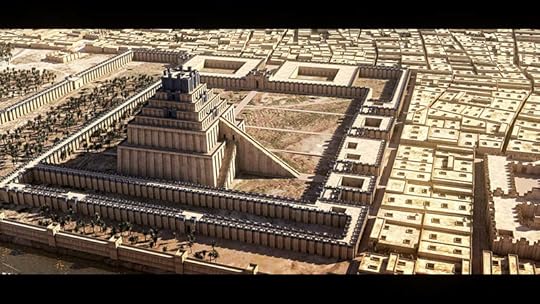 Credit: Babylon 3D
Credit: Babylon 3DDuring this time, a lot of cultural transmissions took place as the Hebrews came into direct contact with the Babylonians. More followed after 539 BCE, when the Persian Empire (led by Cyrus the Great) conquered Babylon and allowed exiled Hebrews to return to Judah*. It was also during this time (6th to 5th century BCE) that the Torah – which includes the Book of Genesis – was being compiled.
To the Hebrews who were forced into captivity in a strange land, this imposing megastructure must have surely felt like a symbol of their oppression. It makes sense then that they would come to depict it as a symbol of avarice, especially after the Babylonian fells to their Persian adversaries (which could only be seen as vindication).
*SIDENOTE: I’ve had this theory since high school that it was during this period that Judaism (and later, Christianity and Islam) picked up the concepts of a dualistic cosmology, the ongoing struggle between good and evil, messianism, heaven and hell, and the Day of Judgement. These are all core concepts in the Zoroastrian faith, which is by some accounts the first monotheistic faith ever to exist and was the state religion of the Persian empire.
Ishtar AscendantNow here is an idea that sort of came together in a reverse fashion. After writing the Formist Series, I felt that the planet Venus deserved more attention. In this series, the capitol of Venus is a floating city known as Ishtar, named for the Babylonian goddess of fertility. In the Babylonian astronomical/astrological tradition, Ishtar was associated with the Morning Star (Venus), and was the basis for Aphrodite and her Roman counterpart, Venus.
In any case, I started with the title for this story, then worked backward to find a mythological source that was suitable. Naturally, I wanted something that would relate to the theme of terraforming Venus, where altering the chemical cycle of the atmosphere will cause torrential rains – aka. The Big Rain (from the 1954 short story by Poul Anderson) – eventually transforming Venus into an ocean planet.
 Terraforming Venus. Credit: Watsisname
Terraforming Venus. Credit: WatsisnameEventually, I came across the ancient Sumerian myth about Innana, which is what the Sumerians called Ishtar (the predecessors of the Babylonians). This tale, titled Innana’s Descent into the Underworld, dates back to the Third Dynasty of Ur (ca. 22nd to 21st century BCE). In this tale, Innana (Ishtar) ventures to Kur, a dark cavern deep underground that is the Sumerian interpretation of the underworld.
The purpose of this visit is to attend the funeral of her sister’s (Ereshkigal) ex-husband and is captured while there. She dies in the process but can be resurrected if food and water are sprinkled on her remains. In time, the god Enki and Innana’s entourage mount a daring rescue, she is brought back to life, and they escape together. She is pursued by demons (galla) who tell her that if she leaves the underworld, she must send someone in her place.
Upon learning that her husband (Dumuzid) has been carrying on like a lecherous hump in her absence, she lets them have him. Like all religious tales, the story is steeped in symbolism and I figure there are some great opportunities for allegorical references. For one, traveling to the underworld sounds an awful lot like going from a space elevator to the surface of Venus, which is a freshly terraformed ocean paradise.
Also, there are the ceremonial vestments that Innana wears that represent her divine powers (her me), which sound comparable to advanced technology that give the user all kinds of capabilities (communications, augmented reality, access to AI, nanotechnology, biomedical implants, weaponry, etc.) And the structure and of the story is quite interesting when adapted to a futuristic setting.
Red Tide RisingFor this idea, I chose to go with the Deluge! This myth is a source of fascination for me, partly because it’s universal in nature, and also because there’s a link between the Biblical account and (again) ancient Sumerian mythology. The story of Noah’s Ark (also contained in the book of Genesis) is the most well-understood in western culture, so I need not repeat it here. What is lesser known is the fact that it bears a striking resemblance to the Akkadian epic Atra-Hasis (dated to the 18th century BCE).
The tale is contained on three clay tablets, the first containing the creation myth, where the gods Anu, Enlil, and Enki (the Sumerian gods of sky, wind, and water) give birth to the world and humanity. Tablet II speaks of human overpopulation and how the gods relied on periodic plagues, famines, and droughts to control them. Finally, Enlil decides to unleash a seven-day flood to wipe out humanity.
 Mars Terraformed. Credit: Daein Ballard
Mars Terraformed. Credit: Daein BallardTablet III is the one that contains the Deluge myth. It begins with Enki warning the titular hero (Atrahasis) of Enlil’s plan to destroy humanity and instructs him to dismantle his house and build a boat to escape. The boat is to have a roof and upper and lower decks to accommodate his family and their animals, which ensures their survival when the flood comes.
Enlil is furious with Enki for violating his oath, but Enki defends his actions and claims he did it to preserve life. They ultimately agree that humanity will live and that other means for controlling the population should be followed. Once again, we see parallels with the Hebrew account, at least as far as the major details are concerned.
In this case, I saw some serious possibilities for a Deluge-themed story involving the terraforming of Mars. After all, transforming the landscape of Mars entails melting its polar caps so the planet can once again have liquid water on its surface. But what if there was a miscalculation and settled lowlands suddenly became threatened? Like I said, potential!
We – Are – Sumer!Another thing I realized while looking through the astrological/astronomical traditions of the ancient Mesopotamians was how these traditions are still alive today. For example, ancient Greek and Roman mythology was heavily influenced by the Sumerians, Babylonians, and Akkadians*. Not only did the Mesopotamians catalog the constellation as the Greeks and Roman knew them (which are today preserved in the form of Zodiac Signs), recent scholarship indicates that the animals we associate with them were established by the early-mid Babylonian period (1800 BCE – 1200 BCE).
*Addendum: Apparently, the ancient Egyptian, Persian, and Hindu traditions are also similar to those of the Mesopotamians, which is clear evidence of transmission, sharing, and/or a common origin.*
Today, we still use the Latin names and associate the planets with their Greco-Roman counterparts. Sure, we’ve since added a few more planets to the rolls, Uranus, Neptune, Pluto (and then reconsidered Pluto’s planet status after finding Ceres, Eris, Sedna, Haumea, Makemake, Orcus, Quaoar, etc.). But the convention with which we’ve named many of these bodies is still consistent with this ancient tradition: from ancient Mesopotamia to Classical Antiquity to modern Western astronomy.
To run it down for you, here are the Sumerian/Babylonian names for those planets that were known to the ancient Sumerians and Babylonians, as well as their Greek and Roman counterparts:
Utu/Shamash (Sun): the god of truth, justice, and mortality, depicted as driving a brilliant chariot across the skythe basis for Helios (Greek pantheon), guardian of oaths and sight, and for the Roman sun god Sol InvictusNabu/Nebo (Mercury): named for the god of literacy, reason, scribes, and wisdom the basis for Hermes, herald of the Freel gods, and the Roman god Mercury (messenger of the gods)Inanna/Ishtar (Venus): goddess of love, fertility, sex, war, and political powerthe basis for Aphrodite, goddess of love, fertility, and sex, and Venus, Roman god of love, fertility, and sexKi/Antu (Earth): mother of the gods, sister of (and consort to) Anu (sky), replaced later by Inanna (Ishtar)the basis for Gaia/Hera, the Greek mother goddess who bore the gods/wife and consort of Zeus (replaced by Aphrodite)later became the basis of Terra (Earth) and Juno in the Roman pantheonNannar/Sin (Moon): god of the Moon, wisdom, and the totality of divine power, depicted as riding a chariot across the skyassociated with Selene, Greek goddess of the Moon, basis for Roman goddess Luna (riding a chariot)Nergal (Mars): god of war, plague, strife, and forest fires, associated with calamitiesthe basis for Ares, the Greek god of war, strife, chaos, and the basis for Mars (Roman god of war)Amarutuk./Marduk (Jupiter): chief of the gods, patron of the city of Babylon and the Babylonian peoplethe basis for Zeus, father, and king of the Olympian gods, and Jupiter (Jove), Roman father of the godsNinurta/Ninib (Saturn): warrior deity, the god of agriculture, and patron god of farmersbasis for Cronos, the Greek god of the harvest, father of the Titans (and Zeus), and Saturn (Roman god of agriculture)As you can see, there are clear signs of cultural transmission. The names changed, but most of the details and the significance remained the same. This is also illustrated in the constellations, where the twelve signs of the zodiac were all drawn from the astrological traditions of Babylon. Here they are, grouped according to their modern name, their ancient name, and their associated symbol:
Aries: “Hired Man” the RamTaurus: “Stars (Pleiades)” the BullGemini: “the Twin” the RoosterCancer: “Crab” the Crab Leo: “Lion” the LionVirgo: “the Barleystalk” the RavenLibra: “the Balance”Scorpio: “Scorpion”Sagittarius: “Pabilsag” the Anzu birdCapricorn: “the Goat-fish” the GoatAquarius: “Great One” the EaglePisces: “the Tails” the Dove/SwallowI can’t speak for everybody, but I sure find this cool. It’s interesting to know that our observations of the heavens and the patterns we’ve applied have very deep roots. And ancient history and the whole question of origins have always lit a fire in my brain!
February 6, 2021
My First (Real) Five Year Plan
The Five Year Plan… chances are, we’ve all heard someone talk about how they have one and hoped that they would be able to achieve all their listed goals by the end of it. While I’m sure most people can’t be bothered to listen to anyone lay out their life plans with anything other than the barest of feigned interest, it does feel like this is something we should all consider.
Somehow, having a plan in place that includes an ultimate goal, concrete steps on how to get there, and a timeline for each step – that just seems like the kind of thing serious people and high-end achievers do, doesn’t it? So I got to thinking a while back that I should start setting goals and a schedule for making them happen, though this would be subject to adjustment along the way.
Quick Sidebar: I’ll admit that the term has always seemed a little iffy to me since this is what Joseph Stalin and the Soviet leaders that succeeded him called their economic plans, and they never ended well! It’s right up there with people who use the term “Political Correctness” in a positive way. As if they don’t know that it’s a Soviet term that was associated with Stalin’s paranoid, murderous scheming!
Ah, whatever, words are wind! And if we’re going to get into the whole original meaning and intent thing, most of the idioms in the English language would be considered suspect! So with this in mind, I began thinking about all the books I would like to write in the near future and when I might be getting around to writing them.
 Credit: Pablo Carlos Budassi
Credit: Pablo Carlos BudassiAfter a modicum of consideration, I have decided that my first real Five Year Plan (2021 – 2025) should look something like this:
2021:Have Formist Series released as a box setFinish work on a special project (more on that later)Keep working on Under Heaven (a standalone book about a lunar colony)Keep working on Reciprocity (a standalone book about cyberwarfare)2022:Finish the Fermi Book (and pick a damn title!)Finish Transverse (standalone in the Formist universe about interstellar travel)Get to work on the next series with The Kuiper Anamoly (Seedling Series #1)2023:Edit and finalize The Kuiper Belt AnomalyStart writing Standoff at Oberon (Seedling Series #2)2024:Edit and finalize Standoff at Oberon Start writing The Sol Gambit (Seedling Series #3)2025:Edit and finalize The Sol GambitRelease The Seedling Series as a boxset Credit: Castrum Press
Credit: Castrum PressBasically, I came up with this plan to figure out what I’m going to do now that I’ve finished the Formist Series, which is my first published trilogy. I’ve had a lot of irons in the fire over the past few years and many of them got put on hold while I finished these novels. At the same time, writing this series gave me new ideas that were either directly or semi-related that I knew I wanted to pursue once I had the time.
Then there’s the standalone novel called Transverse, which takes place aboard a generation ship that is making the journey to another star system (my current choice is HD 85512 b). This story takes place in the Formist universe and involves a faction that is mentioned in the series but not yet heard from (they’re called the Seedlings).
There’s also the standalone novel I’m currently calling Under Heaven. This is a near-future work that takes place on the Moon, which has a permanent human presence on it and an economy that’s built around resource extraction, energy, and lunar tourism. Inspired by the passage of the Artemis Accords, I wondered what it might look like if people on the Moon suddenly found themselves entangled with conflicts back home.
I also want to tackle an idea I came up with a few years ago. Titled Reciprocity, this story takes place in the near future and deals with issues like wealth, poverty, displacement, surveillance, and cyber-security in a world that is beset by climate change and the impending Technological Singularity. I’ve started and stopped it a few times and will not abandon it until I feel that I’ve given it the old college try!
Also, there’s an ongoing collaboration that my friend and colleague Paco suggested a couple years ago. At the time, he told me about a fictional universe he’d created where humanity expanded into the cosmos to create an interstellar empire, which then collapsed. Centuries later, the known-Universe has been carved up into a series of realms controlled by warlords, and the most lucrative industry involves salvaging ancient technology.
The main characters in this story are a group of salvagers who stumble upon an ancient device that could very well tip the balance of power in the known Universe. It doesn’t really have a title yet, but I suggested the name Sovtag Barko – an amalgam of Creole and Filipino that basically means “smuggling vessel”. We’ll have to see what we can do with that one!
I’m reminded of something Eisenhower famously said: “Plans are useless, but planning is essential.” Another wise old tactician (Helmuth von Moltke the Elder) is credited with saying, “No plan survives contact with the enemy.” Substitute “the enemy” with “reality” and I would say this slice of wisdom can apply to everything in life.
Nothing ever goes according to plan, but that doesn’t make planning what you hope to accomplish (and giving yourself a timetable to do it) any less crucial, does it? So this is mine. I hope I live up to it!
 Credit: NASA
Credit: NASA
January 27, 2021
The Fermi Series Will Be Released as a Book!
A few months ago, my boss at Universe Today encouraged me to take on a new writing project. For months now, I’ve been writing a series about the Fermi Paradox. For those who are not familiar, this paradox takes its name from Enrico Fermi, the Italian-American physicist who was instrumental in the development of the atomic bomb and the first nuclear reactor.
As legend has it, it was 1950 and Fermi was having lunch with some colleagues at the Los Alamos Research Laboratory. The conversation soon turned to the subject of UFOs, alleged sightings and abductions, and all the alien hysteria that was sweeping America at the time. Eventually, Fermi was said to have finally asked, “Where is Everybody?”
To his colleagues, and in the context of their conversation, the question’s meaning ran deep. The Universe, the sum total of all matter, energy, and existence is immeasurably vast, but also incredibly quiet. There are an estimated two trillion galaxies out there, each of which has hundreds of billions or even trillions of stars each.
 Credit: ESO
Credit: ESOBased on recent exoplanet surveys, astronomers estimate that there could be 100 to 400 billion planets in our galaxy! Of these, it is estimated that up to 6 billion of these worlds could be similar to Earth in terms of size, mass, and composition (silicate rock and metals). On top of all that, there’s the matter of time.
Life on Earth began roughly four billion years ago and humanity has only been around for the last 200,000 of them. Meanwhile, the Universe has been around for 13.8 billion years and the first galaxies and planets existed as early as 800 million years after the Big Bang (13 billion years ago.)
In summary, the ingredients for life are everywhere and they are in abundance! What’s more, other star systems and their planets have had a significant head start on Earth, so life has had no shortage of time to emerge and evolve considerably. And yet, everywhere we look in the cosmos, we encounter the “Great Silence.” So as Fermi famously asked:
“Where is everybody?” Credit: ESO
Credit: ESONot that long ago, my boss recommended that I take these articles and turn them into a book. And so I began laying the groundwork for it. I decided what I wanted to talk about, how I wanted to structure it, and what I wanted to avoid (mostly based on what’s already been done.) In the past few weeks, what will eventually be the full volume has been taking shape!
Of course, things have been complicated a little by the fact that the article series is not yet finished. I got four (maybe five) more articles to go, and I’m almost positive I’ll feel the need to add more with time. But that’s what happens when you engage in a passion project or labor of love. You find yourself endlessly tweaking because you’re afraid it’s not perfect yet!
What is also very exciting is the fact that the Fermi Series has allowed me to connect with some true luminaries. These include former NASA scientist and SF author David Brin, economics professor and creator of the “Great Filter Hypothesis” Robin Hanson, and famed futurist and creator of the “Transcendence Hypothesis” John Smart, all of whom I hope will stick around to lend some quotes to the book!
I’m thinking something along the lines of “Where Are All the Aliens: the Fermi Paradox for Beginners.” To be clear, the title is not some cheap attempt to emulate the whole “for Dummies” franchise. This book will essentially be a guide to a very serious subject, one that embraces the history of science, astrophysics, astrobiology, and cosmology.
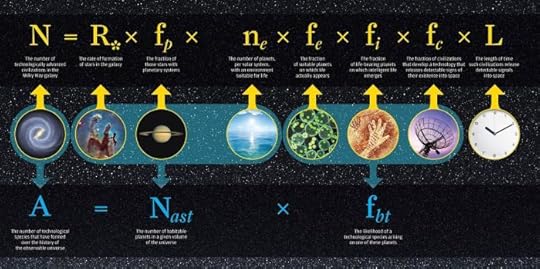 The Drake Equation, illustrated. Credit: exoplanets.nasa.gov
The Drake Equation, illustrated. Credit: exoplanets.nasa.govAnd the whole thing is written by a guy who has no formal training in three out of those four. That’s always been my thing as a science writer and communicator. I’m not an expert, I’m an enthusiast. I love the topic and research it thoroughly so that I can communicate it to other people who are also not experts, but who want to understand it and think its pretty cool!
So that will be my goal with this upcoming book. I can’t give a timeline on it, but I can say that it will probably be finished by the end of 2021. The framework has already been created, much of the content is already done, but it will need some serious reworking (converting articles to a chapter format) before it can be turned over to a publisher.
It would also be fair to say that this book is part of my Five Year Plan (2021-2025), more on that later. Now that the Formist Series is finished, I’ve got a number of other projects that I’m quite excited about. In addition to the Fermi Book, these include a book for an organization I recently joined (can’t talk about that just yet), and three standalone novels (or novellas, remains to be seen).
On top of that, I plan to get get started on a new trilogy that will explore the biggest SF question of all – “Where is Everybody?” Yep, it’s all coming back to that question for these days! Stay tuned, I got plenty more to say on all of that very soon.
January 15, 2021
The Cronian Incident, by Matthew Williams @storybywill @RRBookTours1 #RRBookTours #TheCronianIncident #Scifi
The Blog Tour Continues. Check out Didi Oviatt!
HTML
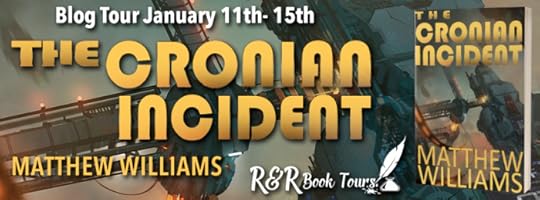
To celebrate the upcoming release of the final installment of The Formist series, we’re going back to where it all started in The Cronian Incident!
Read on for details, excerpt, and a chance to win a signed copy of the book!
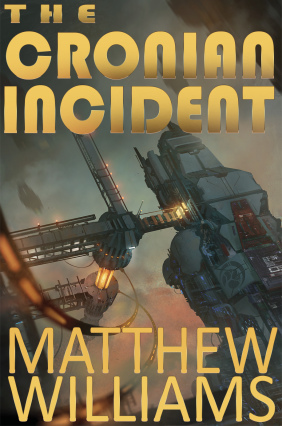 The Cronian Incident ( The Formist #1)
The Cronian Incident ( The Formist #1)
Publication Date: September 2017
Genre: Science Fiction
Jeremiah Ward was just another convict, a disgraced investigator who once worked the Martian beat, now serving his sentence in a mining colony on Mercury. When a member of a powerful faction goes missing on Titan, Ward is given an opportunity he cannot pass up. In exchange for investigating the disappearance of this figure, he gets a clean slate and a second chance.
But, the deeper Ward digs the more secrets he finds. Instead of investigating a missing person’s case he becomes embroiled in a centuries-old conspiracy and Ward comes to realize his…
View original post 1,830 more words
January 11, 2021
Blog Tour: The Cronian Incident by Matthew S. Williams @storybywill @RRBookTours1 #RRBookTours #Scifi
The Formist Series is getting a BLOG TOUR! Check out the dates and fire some “questions for the author” to the participating blogs (if you feel like it)
To celebrate the upcoming release of the final installment of The Formist series, we’re going back to where it all started in The Cronian Incident!
Read on for details, excerpt, and a chance to win a signed copy of the book!
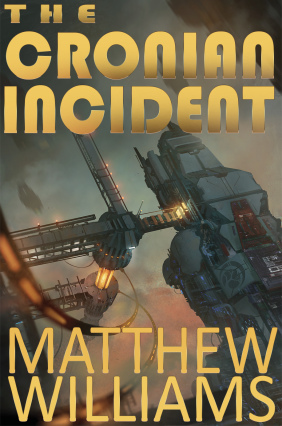 The Cronian Incident ( The Formist #1)
The Cronian Incident ( The Formist #1)
Publication Date: September 2017
Genre: Science Fiction
Jeremiah Ward was just another convict, a disgraced investigator who once worked the Martian beat, now serving his sentence in a mining colony on Mercury. When a member of a powerful faction goes missing on Titan, Ward is given an opportunity he cannot pass up. In exchange for investigating the disappearance of this figure, he gets a clean slate and a second chance.
But, the deeper Ward digs the more secrets he finds. Instead of investigating a missing person’s case he becomes embroiled in a centuries-old conspiracy and Ward comes to realize his one…
View original post 1,926 more words





